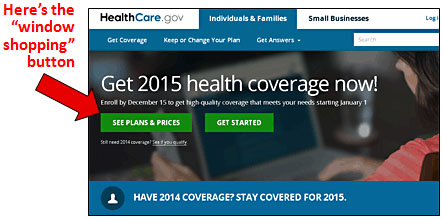Today is the first day of the 2015 signup period for Obamacare. If you currently have coverage, you need to decide whether to keep the plan you have or shop around for a different one. Here are a couple of key things to keep in mind—whether you’re buying coverage for yourself or know friends who are:
- As the New York Times points out today, it’s possible that the net price of your current coverage could go up substantially this year. Here’s why: the size of the federal subsidy depends on the price of your plan relative to other plans. If your plan was the cheapest on offer last year, it qualified for a maximum subsidy. But if other, cheaper plans are offered this year, and your plan is now, say, only the fourth cheapest, you’ll get a smaller subsidy. So even if your actual plan premium stays the same, your net cost could go up a lot.
This is, naturally, becoming a partisan attack point, but don’t ignore it just because the usual suspects are making hay with it. It’s a real issue that anyone buying insurance on a state or federal exchange should be aware of.
Bottom line: shop around. Don’t just hit the renew button without checking things out.
- Andrew Sprung has been writing tirelessly about something called Cost Sharing Reduction. It’s not well known, but it could be important to you. Today, Sprung tells us that the new version of healthcare.gov has a pretty nice shoparound feature that allows you to enter some basic information and then provides a comparison of all plans in your area.
 I tried it myself, and sure enough, the “window shopping” feature works nicely and is easily accessible from the home page.
I tried it myself, and sure enough, the “window shopping” feature works nicely and is easily accessible from the home page.
However, it doesn’t do a good job of steering you toward silver-level plans, which are the only ones eligible for Cost Sharing Reduction. For example, I shopped for a plan for a low-income family of three in Missouri, and the cost of the cheapest bronze plan was $0. The cost of the cheapest silver plan was $90 per month. That’s an extra $1,000 per year, and a lot of low-income families will naturally gravitate toward the cheaper plan, especially since it’s the first one they see.
But the bronze plan has both a deductible and an out-of-pocket cap of $12,600. The silver plan with CSR has a deductible of $2,000 and an out-of-pocket cap of $3,700. Unless you’re literally rolling the dice that you’re never going to see a doctor this year, you’re almost certain to be better off with the silver plan, even though the up-front monthly premium is a little higher.
Bottom line: shop around. The plan that looks cheapest often isn’t, and for low-income buyers a silver plan is often your best bet. For more, here’s the CSR page at healthcare.gov. And for even more, Sprung has details about shopping at the new site here and here.
I guess the bottom line is obvious by now: shop around. Even if you can navigate the website yourself, be careful. Not everything is obvious at first glance. And if you’re not comfortable doing it by yourself, don’t. Get help from an expert in your state. You have three months to sign up, so there’s no rush.














